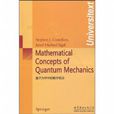圖書信息
外文書名: Mathematical Concepts of Quantum Mechanics
正文語種: 英語
開本: 24
ISBN: 7510005027, 9787510005022
條形碼: 9787510005022
尺寸: 22.2 x 14.8 x 1.4 cm
重量: 399 g
作者簡介
作者:(加拿大)格斯特松
內容簡介
《量子力學中的數學概念(英文版)》介紹了:The first fifteen chapters of these lectures (omitting four to six chapters each year) cover a one term course taken by a mixed group of senior undergraduate and junior graduate students specializing either in mathematics or physics. Typically, the mathematics students have some background in advanced analysis, while the physics students have had introductory quantum mechanics. To satisfy such a disparate audience, we decided to select material which is interesting from the viewpoint of modern theoretical physics, and which illustrates an interplay of ideas from various fields of mathematics such as operator theory, probability, differential equations, and differential geometry. Given our time constraint, we have often pursued mathematical content at the expense of rigor. However, wherever we have sacrificed the latter, we have tried to explain whether the result is an established fact, or, mathematically speaking, a conjecture, and in the former case, how a given argument can be made rigorous. The present book retains these features.
目錄
1 Physical Background
1.1 The Double-Slit Experiment
1.2 Wave Functions
1.3 State Space
1.4 The Schr6dinger Equation
1.5 Mathematical Supplement: Operators on Hilbert Spaces,
2 Dynamics
2.1 Conservation of Probability
2.2 Existence of Dynamics
2.3 The Free Propagator
2.4 Mathematical Supplement: Operator Adjoints
2.5 Mathematical Supplement: the Fourier Transform
2.5.1 Definition of the Fourier Transform
2.5.2 Properties of the Fourier Transform
2.5.3 Functions of the Derivative
3 Observables
3,1 Mean Values and the Momentum Operator
3.2 Observables
3.3 The Heisenberg Representation
3.4 Quantization
3.5 Pseudodifferential Operators
4 The Uncertainty Principle
4.1 The Heisenberg Uncertainty Principle
4.2 A Refined Uncertainty Principle
4.3 Application: Stability of Hydrogen
5 Spectral Theory
5.1 The Spectrum of an Operator
5.2 Functions of Operators and the Spectral Mapping Theorem..
5.3 Applications to Schrodinger Operators
5.4 Spectrum and Evolution
5.5 Variational Characterization of Eigenvalues
5.6 Number of Bound States
5.7 Mathematical Supplement: Integral Operators
6 Scattering States
6.1 Short-raage Interactions:μ> 1
6.2 Long-range Interactions: μ< 1
6.3 Wave Operators
7 Special Cases
7.1 The Infinite Well
7.2 The Torns
7.3 A Potential Step
7.4 The Square Well
7.5 The Harmonic Oscillator
7.6 A Particle on a Sphere
7.7 The Hydrogen Atom
7.8 A Particle in an External EM Field
8 Many-particle Systems
8.1 Quantization of a Many-particle System
8.2 Separation of the Centre-of-mass Motion
8.3 Break-ups
8.4 The HVZ Theorem
8.5 Intra- vs. Inter-cluster Motion
8.6 Existence of Bound States for Atoms and Molecules
8.7 Scattering States
8.8 Mathematical Supplement: Tensor Products
8.9 Appendix: Hartree and Gross-Pitaevski Equations
9 Density Matrices
9.1 Introduction
9.2 States and Dynamics
9.3 Open Systems
9.4 The Thermodynamic Limit
9.5 Equilibrium States
9.6 The T →O Limit
9.7 Example: a System of Harmonic Oscillators
9.8 A Particle Coupled to a Reservoir
9.9 Quantum Systems
9.10 Problems
9.11 Hilbert Space Approach
9.12 BEC at T=O
9.13 Appendix: the Ideal Bose Gas
9.14 Appendix: Beee-Einstein Condensation
9.15 Mathematical Supplement: the Trace, and Trace Class Operators
9.16 Mathematical Supplement: Projections
10 Perturbation Theory: Feshbach Method
10.1 The Feshbach Method
10.2 Example: The Zeeman Effect
10.3 Example: Time-dependent Perturbations
10.4 Appendix: Proof of Theorem 10.1
11 The Eeynman Path Integral ....
11.1 The Feynman Path Integral
11.2 Generalizations of the Path Integral
11.3 Mathematical Supplement: The Trotter Product Formula
12 Quasi-classical Analysis
12.1 Quasi-classical Asymptoties of the Propagator
12.2 Quasi-classical Asymptotics of Green's Function
12.2.1 Appendix
12.3 Bohr-Sommerfeld Semi-classical Quantization
12.4 Quasi-classical Asymptotics for the Ground State Energy
12.5 Mathematical Supplement: Operator Determinants
13 Mathematical Supplement: The Calculus of Variations.
13.1 Functionals
13.2 The First Variation and Critical Points
13.3 Constrained Variational Problems
13.4 The Second Variation
13.5 Conjugate Points and Jacobi Fields
13.6 The Action of the Critical Path
13.7 Appendix: Connection to Geodesics
14 Resonances
14.1 Tunneling and Resonances
14.2 The Free Resonance Energy
14.3 Instantons
14.4 Positive Temperatures
14.5 Pre-exponential Factor for the Bounce
14.6 Contribution of the Zero-mode
14.7 Bohr-Sommerfeld Quantization for Resonances
15 Introduction to Quantum Field Theory
15.1 The Place of QFT
15.1.1 Physical Theories
15.1.2 The Principle of Minimal Action
15.2 Klein-Gordon Theory as a Hamiltoulan System
15.2.1 The Legendre Transform
15.2.2 Hamiltoninns
15.2.3 Poison Brackets
15.2.4 Hamilton's Equations
15.3 Maxwell's Equations as a Hamiltonian System
15.4 Quantization of the Klein-Gordon and Maxwell Equations..
15.4.1 The Quantization Procedure
15.4.2 Creation and Annihilation Operators
15.4.3 Wick Ordering
15.4.4 Quantizing Maxwall's Equations
15.5 Fock Space
15.6 Generalized Free Theory
15.7 Interactions
15.8 Quadratic Approximation
15.8.1 Further Discussion
15.8.2 A Brief Remark on Many-body Hamiltonians in Second Quantization and the Hartree Approximation .
16 Quantum Electrodynamics of Non-relatlvistic Particles:The Theory of Radiation
16.1 The Hamiltonian
16.2 Perturbation Set-up
16.3 Results
16.4 Mathematical Supplements
16.4.1 Spectral Projections
16.4.2 Projecting-out Procedure
17 Supplement: Renormalization Group
17.1 The Decimation Map
17.2 Relative Bounds
17.3 Elimination of Particle and High Photon Energy Degrees of Freedom
17.4 Generalized Normal Form of Operators on Fock Space
17.5 The Hamiltonian H0(ε, z)
17.6 A Banach Space of Operators
17.7 Rescaling
17.8 The Renormalization Map
17.9 Linearized Flow
17.10 Central-stable Manifold for RG and Spectra of Hamiltonians
17.11 Appendix
18 Comments on Missing Topics, Literatnre,and Further Reading
References
Index

